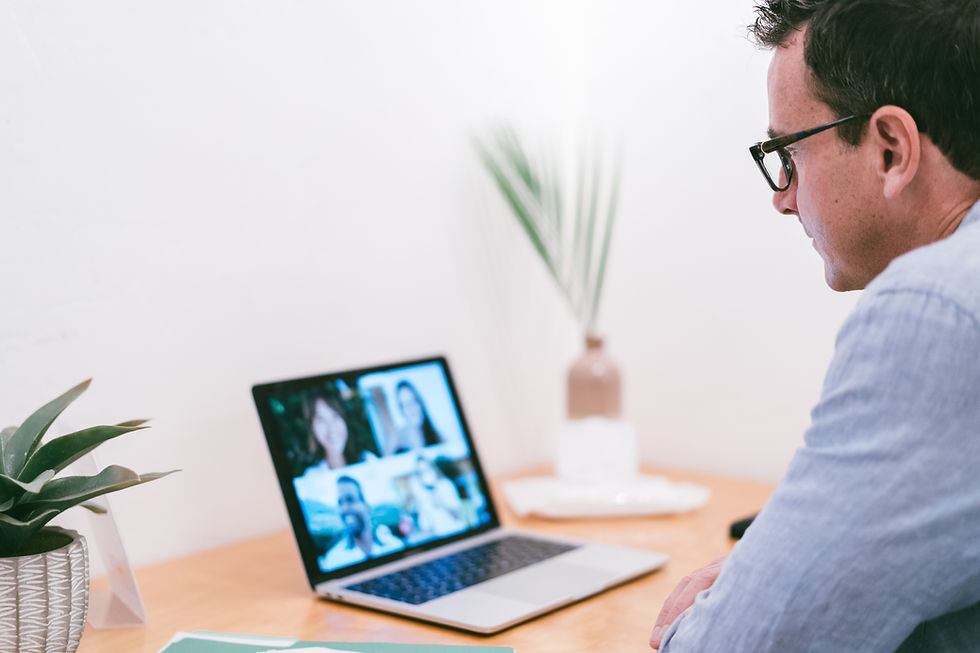Virtual Therapy: Make it Worth Your While!
- Taylor Brown
- Jan 16, 2023
- 4 min read

Ah, the polarizing world of virtual therapy. Some love it, some hate it, but everyone's got an opinion on it.
Virtual therapy was relatively rare and/or nearly unheard of by most until 2020 when the Covid pandemic hit. At this point it became the only option to continue important and critical mental health/psychiatric care. We couldn't just leave our clients high and dry, could we? It was a huge relief to be able to continue our work when the world so badly needed support.
But then everything else became virtual too and much has stayed that way. Restaurants are entirely digitized, QR codes are everywhere, and Zoom meetings are seemingly a fact of life. What was a helpful blessing at first then became a frustration... when were we ever going to get back to human-to-human contact?
There's no doubt about it... therapy is based on human connection which is inevitably harder through a screen. There is so much about body language that can be missed when virtual, and it can be harder to get a feel for the intangible, the unspoken things, and the air around someone. Therapists have to adjust the way they approach individuals in order to gain the same amount of information. What I once was able to glean from simply observing a client's posture, I now must verbally ask or dig deeper for.
But there are incredible benefits as well:
Busy people with complicated schedules are able to finally add therapy to their lives because they can do it while their children nap, while on a lunch break at work without having to take extra time off, or from their car at soccer practice.
People with chronic illness or disabilities can continue to get care without further compromising their health.
Folks in rural communities can finally have their pick of therapists in their state.
Symptoms of depression, anxiety, or PTSD that have made it hard for some to leave the house can be addressed in the comfort of their home.
In order to maximize the benefits of virtual therapy it cannot be viewed as an afterthought. That one hour session needs to be prioritized the same way an in-person session would be, but how to do that? Here are my favorite tips to make a virtual therapy session more effective and meaningful.
1. Dedicate a space

It's all too easy to simply plop on your couch when it's time for session. But for the same reasons it's recommended to have a dedicated work space in your home, it's important for therapy too. Part of the reason in-person sessions are so impactful is because that space exists solely for therapy. It's what you're there to do, there's nothing else going on at the time, and it's a safe space. Mimicking this same environment at home can help you focus on therapy and maximize the time.
Don't have an extra space to dedicate just to therapy? No problem! You can make small, subtle changes to a space that already exists. Here are some easy (and free!) ideas:
Change the lighting (switch overheads to lamps, but just be sure your therapist can still see you)
Light your favorite candle
Switch out the chair you're sitting in
Open or close the blinds
Set up the items you'll need (tissues, fidgets, etc.)
Turn on white noise sounds to prevent anyone nearby from overhearing (you can find white noise clips on YouTube and set it outside your door)
With consistency your brain will begin to associate these changes with therapy time, thus helping you focus and get in the zone faster.
2. Set the stage

Make sure your surroundings are as conducive to therapy as possible. This means clear all distractions from your field of vision. Put your phone in another part of the room, turn off all other electronics, put away to-do lists, work notes, bills, etc., and consider whether the window you're sitting by offers a distracting view onto a busy street.
3. Choose a laptop over a phone

If possible, use a computer for virtual sessions rather than your phone. This frees up your hands and ultimately offers more comfort over the course of an hour. It also reduces the chance you'll drop the phone, the battery will die, or you get distracted with notifications. If you have to use your phone, Do Not Disturb is a MUST.
4. Set boundaries

Your family and friends are not likely to follow you to your therapist's office and barge into session to ask you a simple question, right? The same boundaries should exist for virtual therapy! Your friends and family can learn to take this time seriously if you take it seriously and maintain proper boundaries. Here are some ways you can keep your therapy time sacred and convey its importance:
Frequent verbal reminders that you are not to be interrupted
Put a sign on your door
Do Not Disturb activated on your phone
White noise machine outside your door to prevent overhearing
Have the door locked (if possible and/or safe to do so)
Use headphones to help you focus and reduce external distractions
Close blinds / window shades in offices
5. Stop looking at yourself

Seriously. I get it, we all do it, but there is nothing more distracting than watching your own face in that tiny box of the video call. You don't watch yourself in your therapist's physical office, so don't do it virtually!
Make your own square as small as possible in whatever program you are using by changing the gallery view. Then train yourself to focus on your therapist the same way you would in person. This will take time and consistency to break the habit, but I can almost guarantee you will focus better and move deeper into the therapeutic process when you aren't distracted with how you look.
Maybe you haven't tried virtual therapy or maybe you have but didn't have a great experience. I hope that by using these tips you are able to give it another try (or try for the first time) and see if it can work for you!


Comments